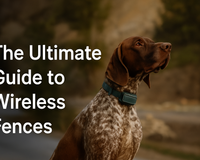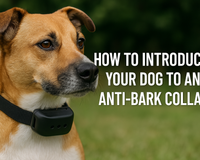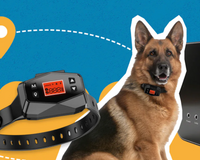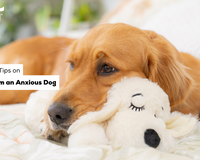Training a rescue dog is one of the most rewarding and potentially challenging things you will ever do. But training a rescue dog is not like training a puppy; you can’t use generic dog training advice on them and expect to see positive results.
You’ll need to tailor your training to your rescue dog, and along the way, manage your expectations and mindset to see training success. We answer the common questions about rescue dogs and explain how you start training a rescue dog so that you can bond with your new fur-baby even quicker.
Is it Hard to Train a Rescue Dog?
This question is impossible to answer; it depends on the dog, the breed, its experience with its previous owner, the level of training it had before you adopted it and if the rescue shelter impacted its personality.
So yes, training a rescue dog can be challenging, but it can also be easier than you expect, it just depends on the dog you rescue and your dog training expectations.
How Long Does it Take a Rescue Dog to Adjust?
This answer varies. But have some empathy for rescue dogs, they have been taken from their first (or even second) home, and moved to a rescue shelter.
In that process, they lost whatever routine they had and went into a brand new environment with many new dog friends. Then, you adopt them and take them somewhere new again.
They need to get used to a brand new routine, a new home, a new bed, and learn how to communicate with you. It will take at least a week for your dog to adjust to all of this change.
Tips for Helping Your Rescue Dog Adjust:
- Create a calm environment for your new dog and minimise the number of toys and people they interact with when they first come in to avoid overwhelming them
- Make sure they sleep wherever their designated sleeping spot will be.
- When you introduce your new rescue dog to more family members, allow the dog to approach them first.
- Whimpering through the night is completely normal, sleeping in a new place can feel quite scary.
- Limit the amount of space they have access to, again to ensure they aren’t overwhelmed.
- Remember to take them out to the toilet before bed; hopefully, this will avoid any accidents
- If the rescue or dog shelter had a routine that suits your lifestyle, try and stick with it. This familiarity will be good for your new rescue dog.
- Ideally, make sure you’re home and not away at work for the first few days. Time spent together initially helps you get to know your new dog. They can get to know you, and you’re there to help them as they adjust.
- If you know they are leash trained, take them on a walk around their new neighbourhood. Don’t let them off the leash yet though.

How Do You Start Training a Rescue Dog?
First, you need to identify what behavioural issues your dog has. This helps with knowing where to start your training efforts. Your shelter or rescue home should provide you with behavioural traits/history on your new rescue dog.
Let's go through the common behavioural issues that rescue dogs have.
1. Food Aggression
Dog food aggression is where a dog shows hostility and threatens others when they approach its food. The main goal is to teach them that if someone approaches their food, it is a neutral or positive experience, not a negative one.
The training around this involves walking past while they eat, dropping even yummier food into their bowl while they eat and teaching them to wait for your command to eat.
2. Jumping Up On People
When a dog jumps up on someone, to them, it’s how they say “hello, I’m happy to see you!”
For a human, however, this can be annoying and potentially dangerous. When a dog jumps up on people, it often means they did this as a puppy, and this behaviour was left uncorrected out of them. To train this out of your dog, you will need a lot of patience as it’s such an ingrained habit.
To train this out of your dog, you must not reward them with your attention when they jump. That means turning around and ignoring the dog until they greet you with no jumping. We have a whole blog on it here explaining exactly how you can train your dog to stop doing this.
3. Excessive, Nuisance Barking
If your rescue dog is excessively barking, this could be the reason why they went to a shelter. But they are lucky to have you, an owner who wants this behaviour trained out of them so you can both live in peace together.
We’ve put together a heap of tips on excessive barking, as this is the primary concern for most of our customers. To train this out of your rescue dog, you’ll need to wear them out, keep them stimulated and block their view if they are barking at a trigger.
4. Separation Anxiety
Teaching your new rescue dog that you’re coming home, and there’s no need to have separation anxiety, is challenging. This training issue will be a trickier one to solve, as it relies on trust and desensitisation.
You need to desensitise your dog to your coming and going. That means grabbing your keys randomly, so they don’t associate the noise with you leaving. Avoid making a huge fuss when you walk in or out of the door because your coming and going is no big deal.
Gradually increase the duration of your departure, and make sure your dog has plenty to do whilst you're gone. Enrichment toys like puzzle games, KONG toys and more will keep them stimulated and distracted.
5. Aggression
Dog aggression is usually caused by fear and anxiety. It sends the dog into a reactive state, often when they are in this state, they can’t control their reactions and may bite or snap.
If your rescue dog shows signs of aggression, the first thing to do is go to the vet. Ensure there are no underlying medical issues are causing them pain, a dog in pain will often be aggressive.
If the vet gives your dog the all clear, you need to explore why they are aggressive, and once you know the “why”, you will need to desensitise them to that trigger.
There are different aggression stages, and multiple ways you can manage it, learn more about dog aggression.
6. Escaping
A rescue dog that escapes, jumps over fences or digs under them, is usually a scared, anxious, or frustrated dog.
There are two parts to training this out of your rescue dog. Firstly, make sure they can’t escape. Increase your fence’s height, improve your property boundary and make sure they can’t dig their way to the neighbours.
Secondly, try and discover what triggers them. If the dog tries to escape straight after you leave, it is likely to be separation anxiety. If it’s because of frustration and boredom, they may have destroyed other things first.
Your rescue dog will need more enriching toys and more activities that take up tire them out physically and socially. Tiring them out, and giving them plenty to do will be essential.
7. Obedience Training
Obedience training is a must, even if your rescue dog has some basic commands down already. Solidifying this training will make all future training interactions together more straightforward and quicker.
Plus, it’s likely you don’t use the same language as their previous owner, so you need to train your dog obedience with your communication style.

Common Mistakes People Making When Training a Rescue Dog
There are a lot of common mistakes people make when training a rescue dog. Most revolve around being too strict, too relaxed, or overwhelming the dog.- Avoid introducing your new rescue dog to other pets immediately, instead, give them a few hours to settle into their new home and then make introductions.
- Make sure you properly educate children (and adults) on interacting with a dog safely. Read up on safe interaction tips.
- Allowing the dog to behave; however, they please because you feel bad about their past home will not benefit you or the dog in the future.
- Letting the dog play around the entire house and backyard before training isn’t ideal. Ensure you keep them in a space where they can eat, drink, sleep and go to the toilet first. Gradually increase the size of the area they are allowed in, but training together should start first.
- When walking together, don’t let anyone approach your new rescue dog suddenly. And keep them on the lead until you know they will react safely.
If you have any problems training your rescue dog, we recommend you talk to your vet or engage with a behavioural specialist.
And if you’d like to stay up to date on all things dog training, sign up to our newsletter. We sent regular dog training tips, tricks and hacks so you and your furry friend can live in harmony!











